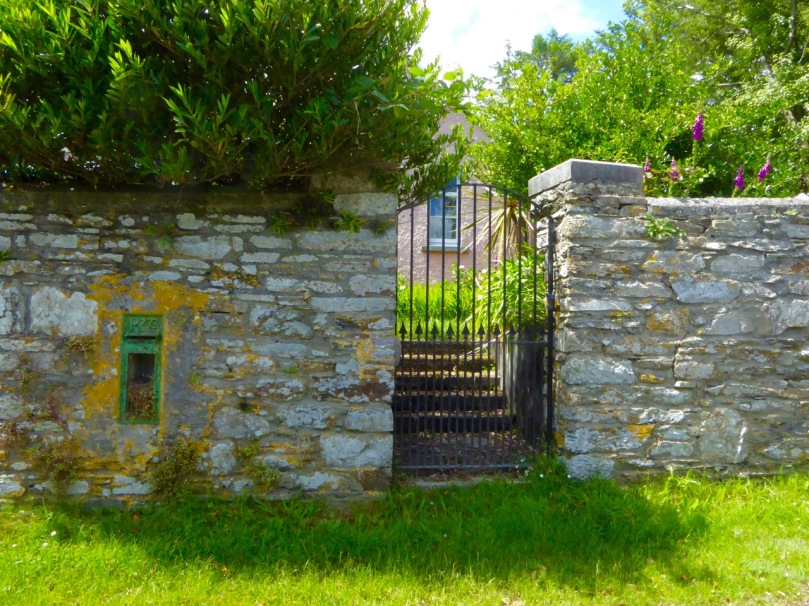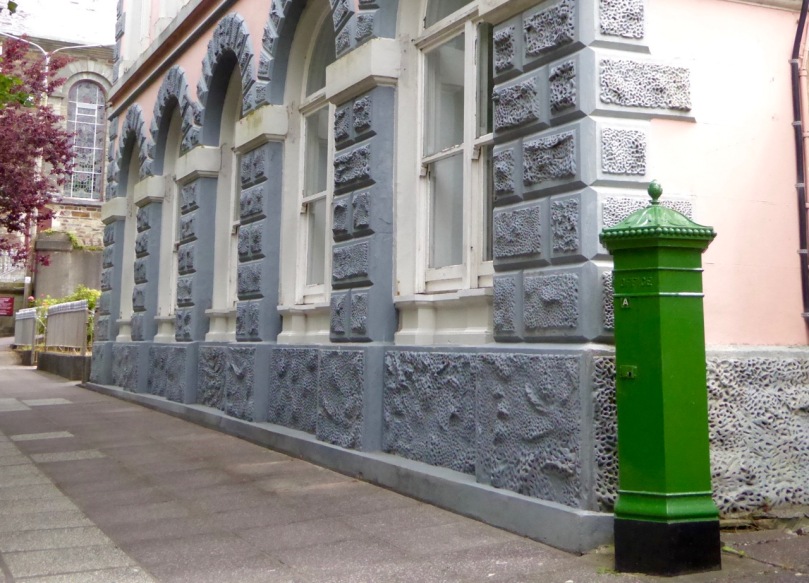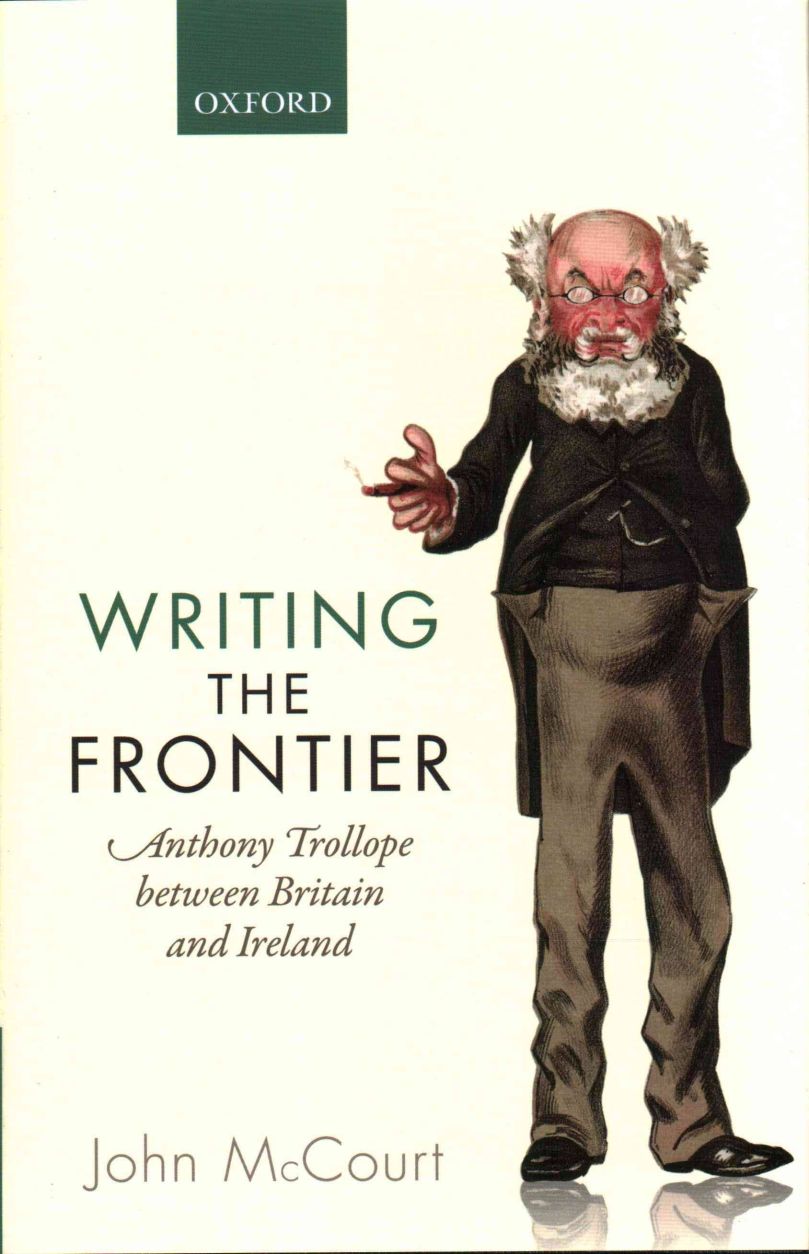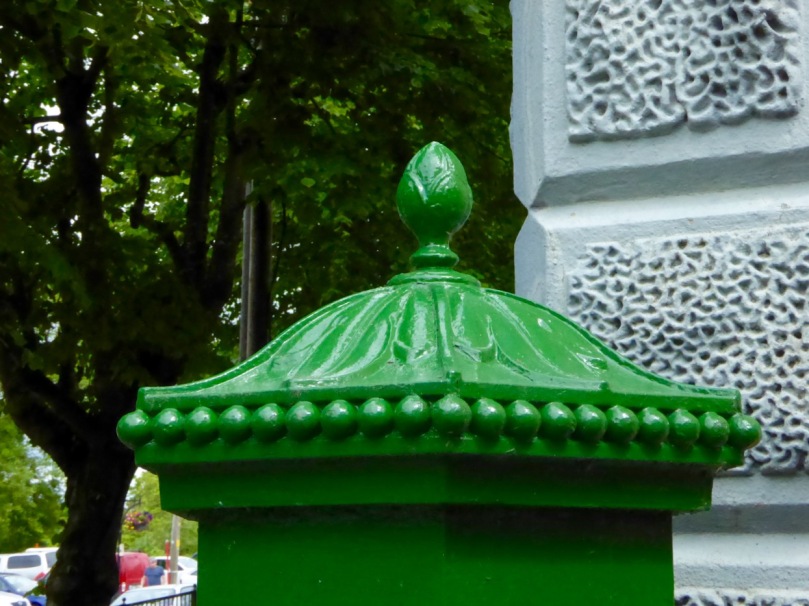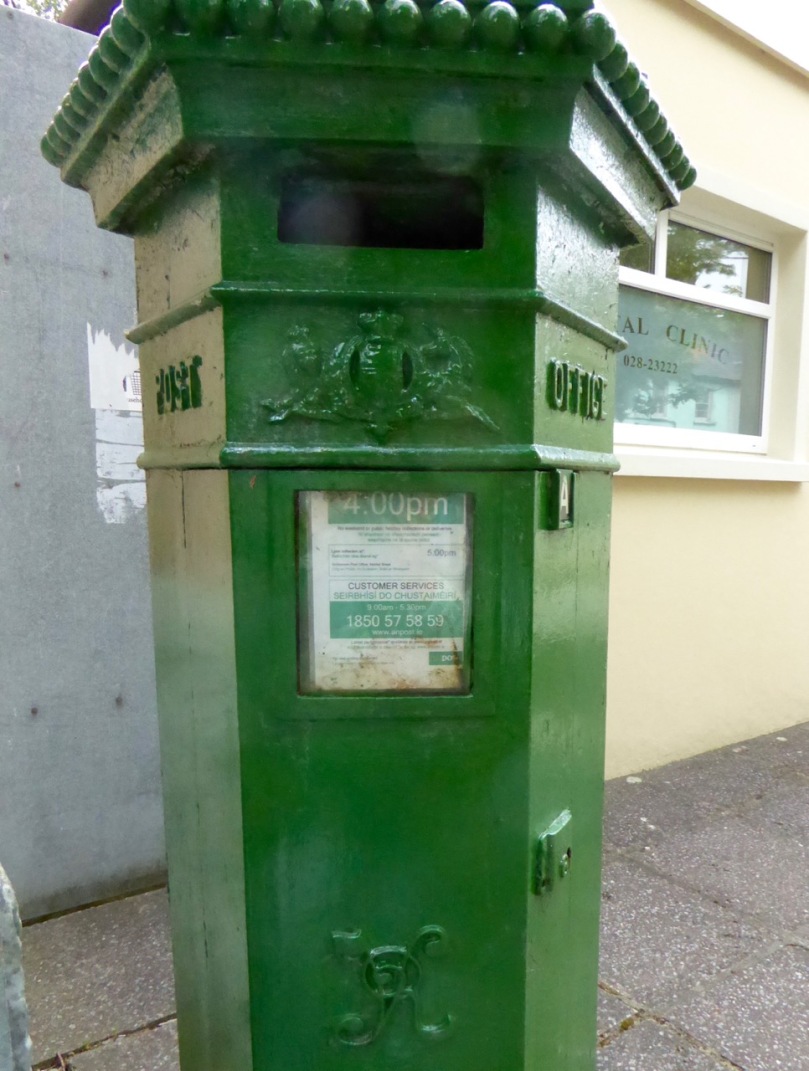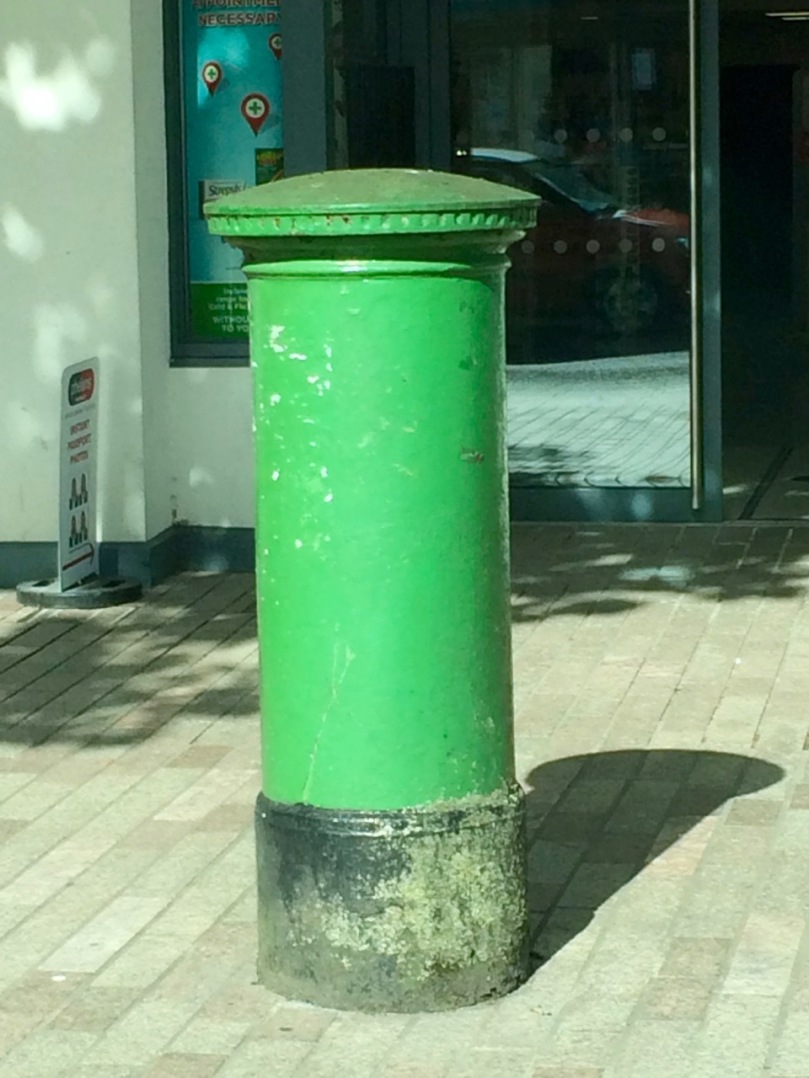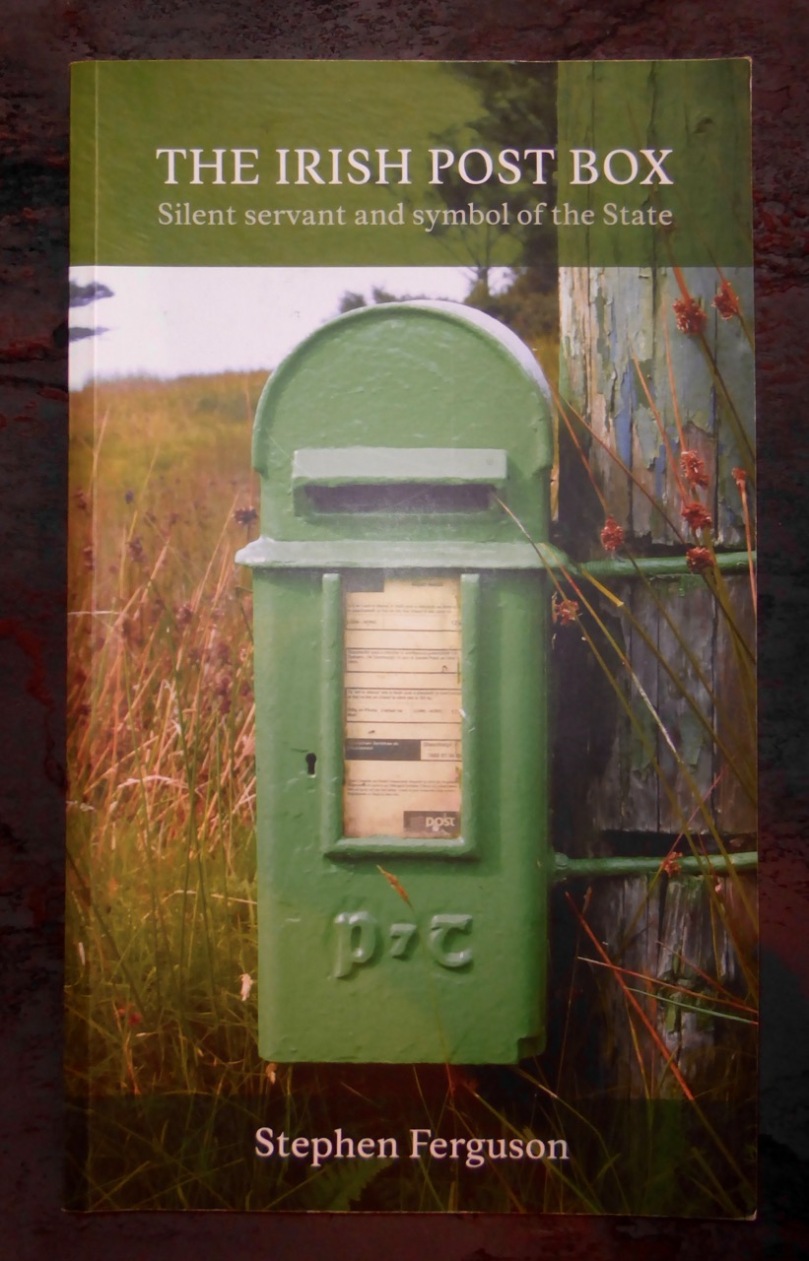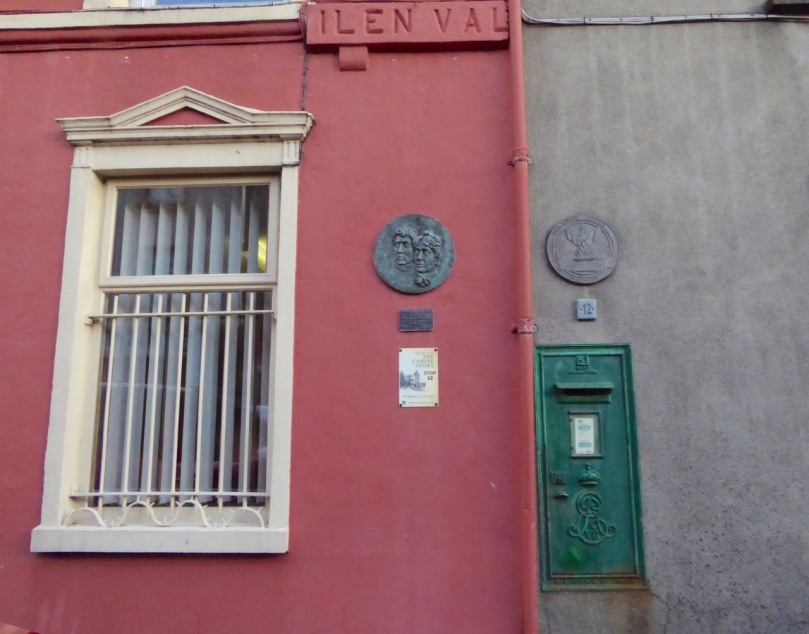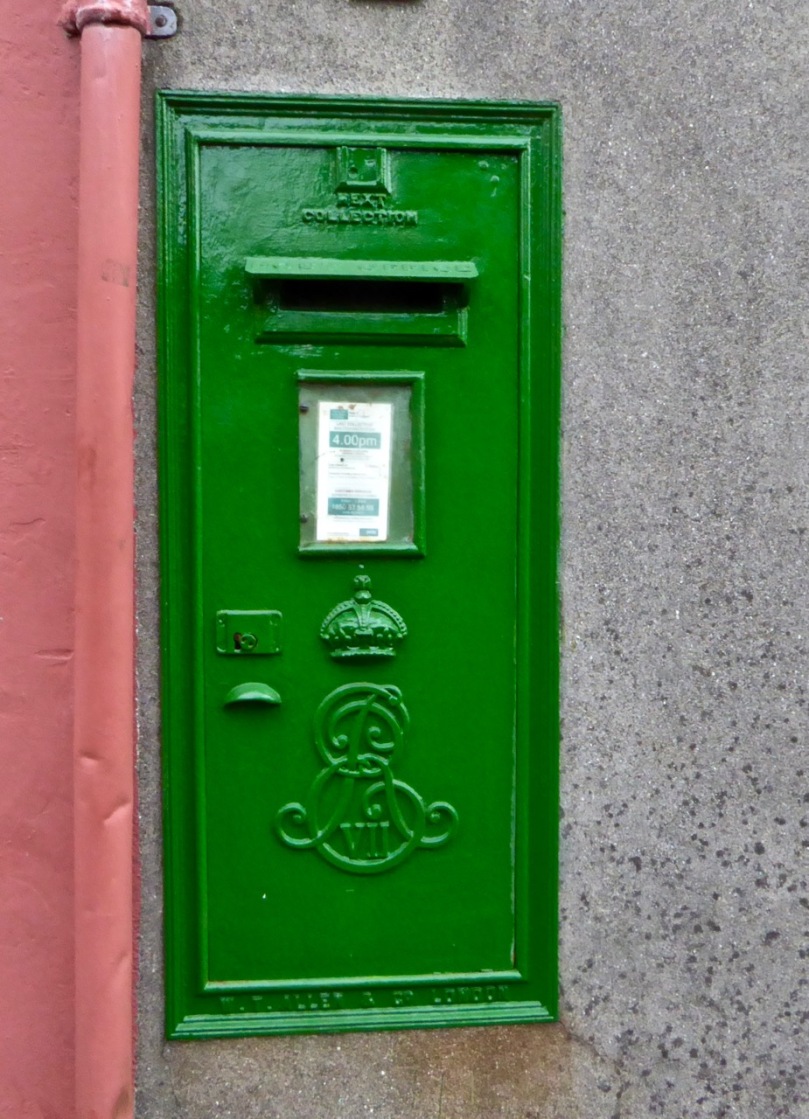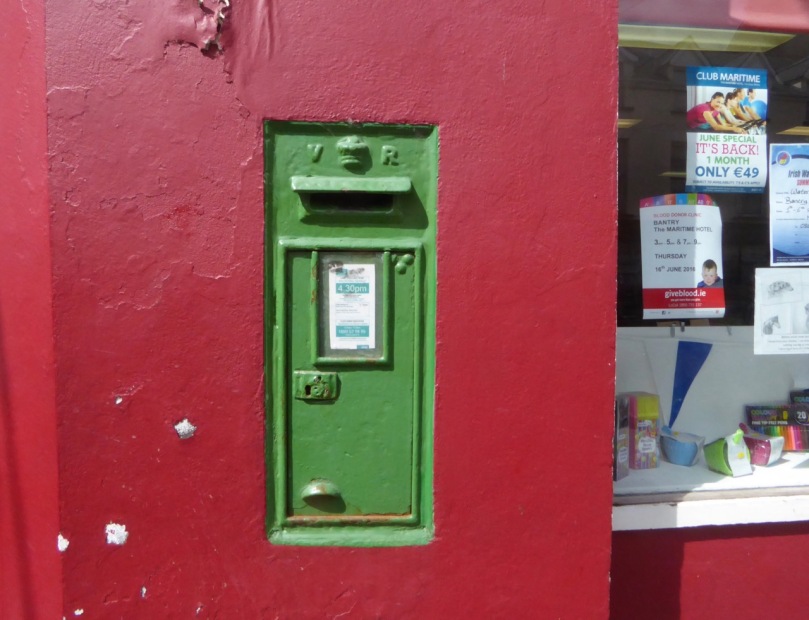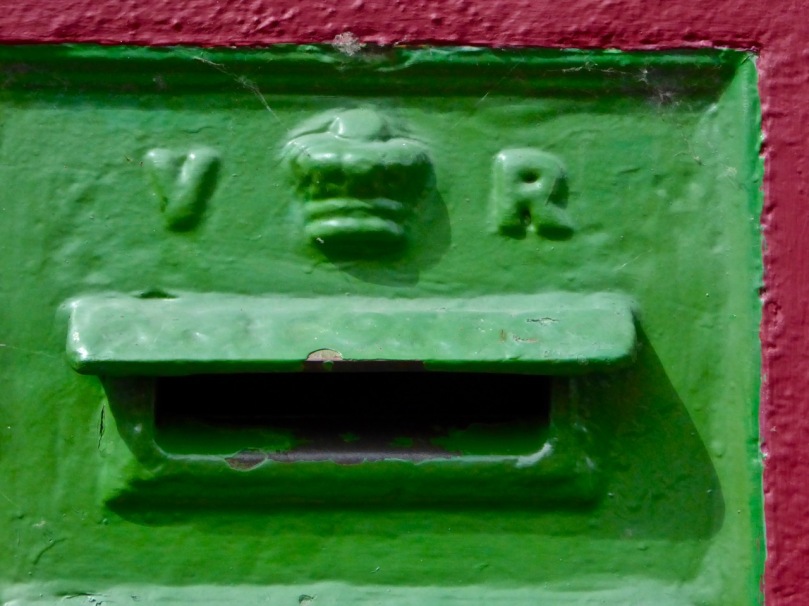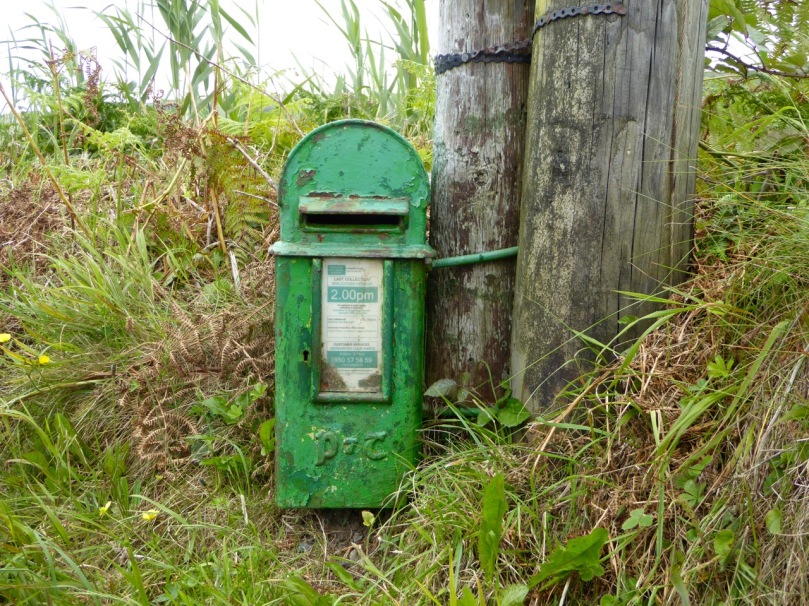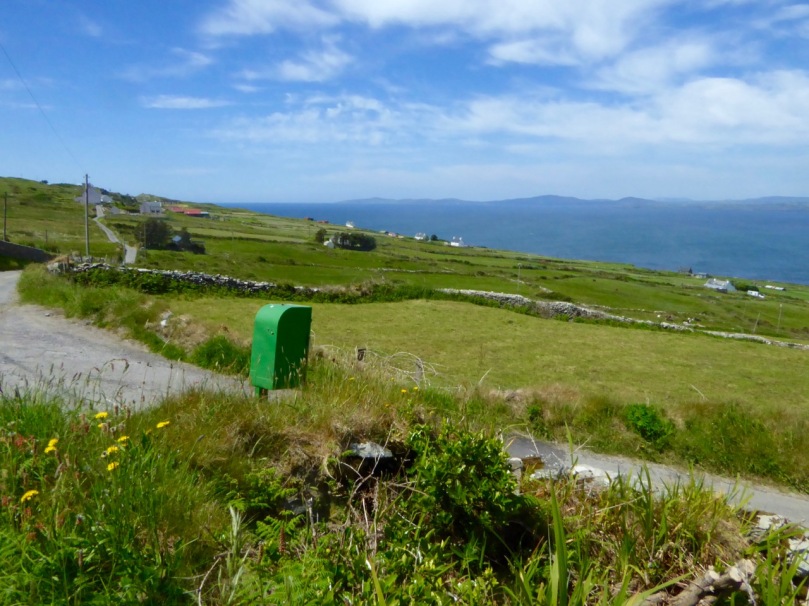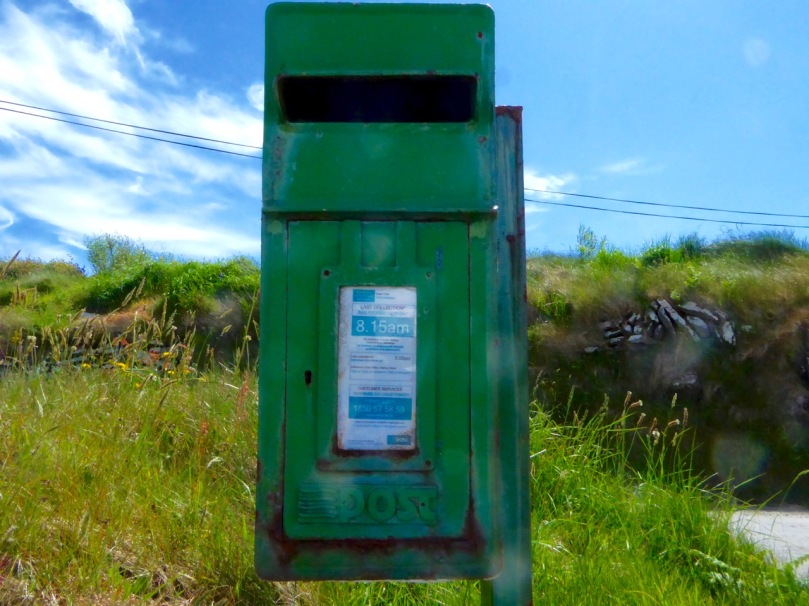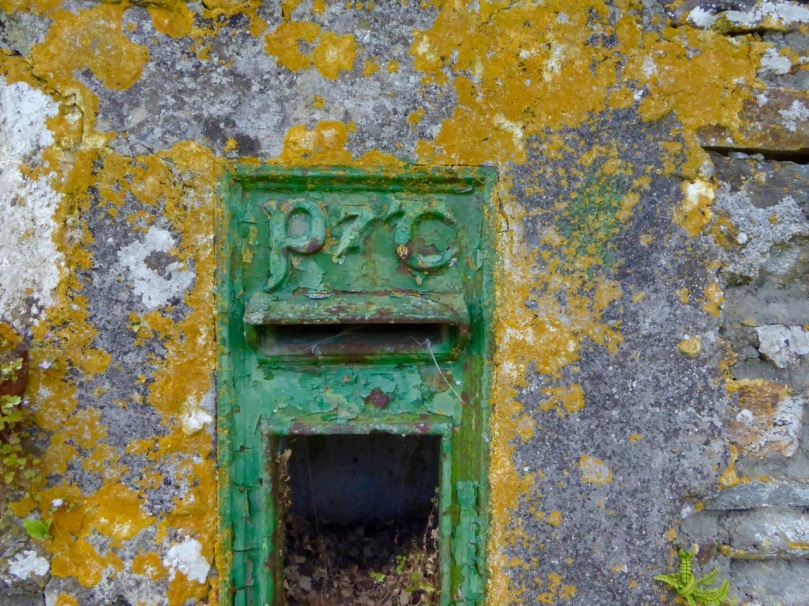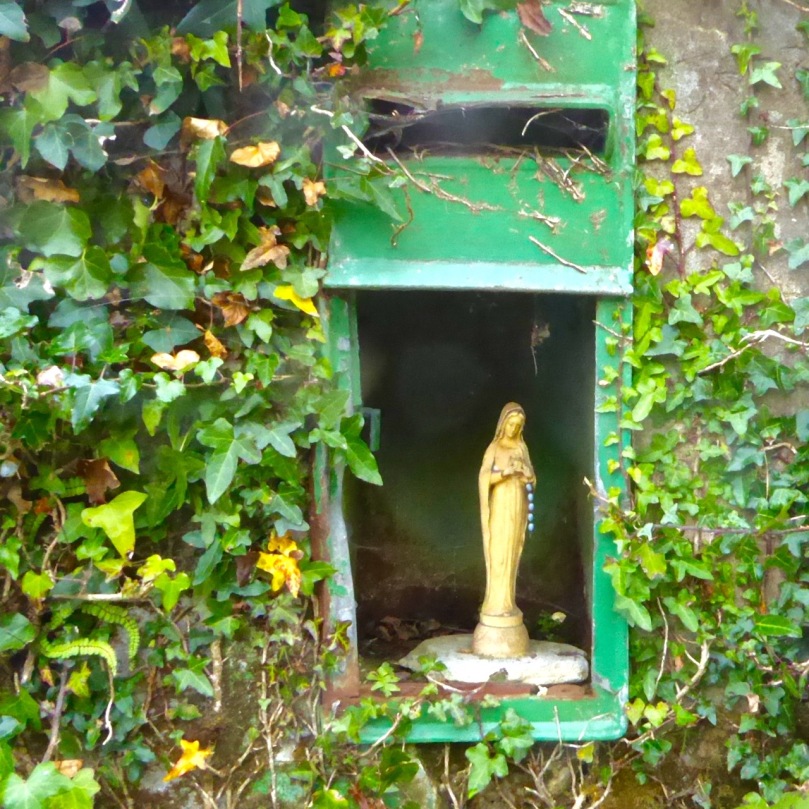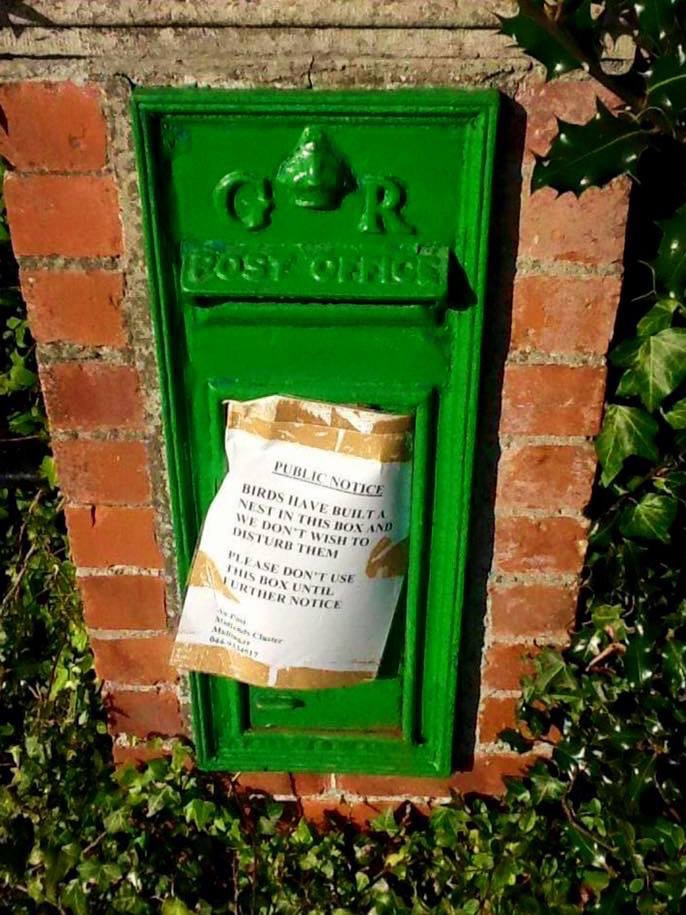-

 35cm x 45cm Cashel Co Tipperary Classic photograph depicting the physicality of the game of Hurling,Irelands national obsession as the ash Hurley is broken in two after colliding with the opposing players helmet as traditional rivals Clare and Tipperary battle for supremacy at Semple Stadium Thurles.
35cm x 45cm Cashel Co Tipperary Classic photograph depicting the physicality of the game of Hurling,Irelands national obsession as the ash Hurley is broken in two after colliding with the opposing players helmet as traditional rivals Clare and Tipperary battle for supremacy at Semple Stadium Thurles. -

 Ennis Co Clare 50cm x 60cm De Valera was a near demagogue type politician who dominated Irish Political life from 1917 to 1973,whether as Prime Minister or President or as leader of the Opposition.Known as the Long Fella,Irish people either loved or hated him-there was simply no ambivalent feelings about this most polarising of politicians.This fine portrait of De Valera catches him perfectly and would make a superb addition to any Irish Pub ,both at home or abroad with a Fianna Fail or Republican bias or anyone from Clare,a county where he was always at his most popular. Eamon de Valera, first registered as George de Valero; changed some time before 1901 to Edward de Valera;14 October 1882 – 29 August 1975) was a prominent statesman and political leader in 20th-century Ireland. His political career spanned over half a century, from 1917 to 1973; he served several terms as head of government and head of state. He also led the introduction of the Constitution of Ireland. Prior to de Valera's political career, he was a Commandant at Boland's Mill during the 1916 Easter Rising, an Irish revolution that would eventually contribute to Irish independence. He was arrested, sentenced to death but released for a variety of reasons, including the public response to the British execution of Rising leaders. He returned to Ireland after being jailed in England and became one of the leading political figures of the War of Independence. After the signing of the Anglo-Irish Treaty, de Valera served as the political leader of Anti-Treaty Sinn Fein until 1926, when he, along with many supporters, left the party to set up Fianna Fáil, a new political party which abandoned the policy of abstentionism from Dáil Éireann. From there, de Valera would go on to be at the forefront of Irish politics until the turn of the 1960s. He took over as President of the Executive Councilfrom W. T. Cosgrave and later Taoiseach, with the passing of Bunreacht Na hEireann (Irish constitution) in 1937. He would serve as Taoiseach on 3 occasions; from 1937 to 1948, from 1951 to 1954 and finally from 1957 to 1959. He remains the longest serving Taoiseach by total days served in the post. He resigned in 1959 upon his election as President of Ireland. By then, he had been Leader of Fianna Fáil for 33 years, and he, along with older founding members, began to take a less prominent role relative to newer ministers such as Jack Lynch, Charles Haughey and Neil Blaney. He would serve as President from 1959 to 1973, two full terms in office. De Valera's political beliefs evolved from militant Irish republicanism to strong social, cultural and economic conservatism.He has been characterised by a stern, unbending, devious demeanor. His roles in the Civil War have also portrayed him as a divisive figure in Irish history. Biographer Tim Pat Coogan sees his time in power as being characterised by economic and cultural stagnation, while Diarmaid Ferriter argues that the stereotype of de Valera as an austere, cold and even backward figure was largely manufactured in the 1960s and is misguided.
Ennis Co Clare 50cm x 60cm De Valera was a near demagogue type politician who dominated Irish Political life from 1917 to 1973,whether as Prime Minister or President or as leader of the Opposition.Known as the Long Fella,Irish people either loved or hated him-there was simply no ambivalent feelings about this most polarising of politicians.This fine portrait of De Valera catches him perfectly and would make a superb addition to any Irish Pub ,both at home or abroad with a Fianna Fail or Republican bias or anyone from Clare,a county where he was always at his most popular. Eamon de Valera, first registered as George de Valero; changed some time before 1901 to Edward de Valera;14 October 1882 – 29 August 1975) was a prominent statesman and political leader in 20th-century Ireland. His political career spanned over half a century, from 1917 to 1973; he served several terms as head of government and head of state. He also led the introduction of the Constitution of Ireland. Prior to de Valera's political career, he was a Commandant at Boland's Mill during the 1916 Easter Rising, an Irish revolution that would eventually contribute to Irish independence. He was arrested, sentenced to death but released for a variety of reasons, including the public response to the British execution of Rising leaders. He returned to Ireland after being jailed in England and became one of the leading political figures of the War of Independence. After the signing of the Anglo-Irish Treaty, de Valera served as the political leader of Anti-Treaty Sinn Fein until 1926, when he, along with many supporters, left the party to set up Fianna Fáil, a new political party which abandoned the policy of abstentionism from Dáil Éireann. From there, de Valera would go on to be at the forefront of Irish politics until the turn of the 1960s. He took over as President of the Executive Councilfrom W. T. Cosgrave and later Taoiseach, with the passing of Bunreacht Na hEireann (Irish constitution) in 1937. He would serve as Taoiseach on 3 occasions; from 1937 to 1948, from 1951 to 1954 and finally from 1957 to 1959. He remains the longest serving Taoiseach by total days served in the post. He resigned in 1959 upon his election as President of Ireland. By then, he had been Leader of Fianna Fáil for 33 years, and he, along with older founding members, began to take a less prominent role relative to newer ministers such as Jack Lynch, Charles Haughey and Neil Blaney. He would serve as President from 1959 to 1973, two full terms in office. De Valera's political beliefs evolved from militant Irish republicanism to strong social, cultural and economic conservatism.He has been characterised by a stern, unbending, devious demeanor. His roles in the Civil War have also portrayed him as a divisive figure in Irish history. Biographer Tim Pat Coogan sees his time in power as being characterised by economic and cultural stagnation, while Diarmaid Ferriter argues that the stereotype of de Valera as an austere, cold and even backward figure was largely manufactured in the 1960s and is misguided. -
Out of stock

 This small but distinctive mirror advertises Ireland’s original gin manufacturer. Thanks to Gins recent renaissance, Corks very own variety has been joined by a number of new gin distilleries in most notably Dingle etc, 35cm x 25cm. Cork
This small but distinctive mirror advertises Ireland’s original gin manufacturer. Thanks to Gins recent renaissance, Corks very own variety has been joined by a number of new gin distilleries in most notably Dingle etc, 35cm x 25cm. CorkGin has moved on from it’s “mother’s ruin” image to become the drink of choice for the younger set.
Gin has a very mixed history. Traditionally the G&T has been the favoured tipple of middle-class Ireland, consumed in golf and yacht clubs throughout the country. More recently it has become very fashionable with a younger age-group as the base for exotic cocktails dreamed up by mixologists in trendy bars and night clubs. But historically it has a more dubious reputation, once known as “Mother’s Ruin”.
The man credited with inventing gin is 17th-century Dutch physician Franciscus Sylvius, although flavoured spirits had been used by monks as medical treatments for centuries before. Gin became popular first with Dutch soldiers, and then English mercenaries, seeking reassurance before battle, hence the phrase Dutch courage. It was brought back to England, but only really became popular under the reign of William of Orange. At that time, the British parliament passed laws permitting anyone to distil gin, at the same time increasing duties on French brandy. Gin rapidly became the binge drink of its day, with the infamous gin palaces of London serving the spirit, often in very crude form and at very cheap prices. It is estimated that there may have been 15,000 such establishments in London alone, famously celebrated in Hogarth’s engravings.
Cork Dry Gin is an Irish gin. First produced in Cork in the Watercourse Distillery circa 1793. Since 1975, Cork Dry Gin has been manufactured by Irish Distillers, a subsidiary of Pernod Ricard, at their Midleton Distillery. Cork Dry Gin is the largest selling gin brand in Ireland. Until recently, bottles of Cork Dry Gin still featured the name of the Cork Distilleries Company, which had purchased the Watercourse Distillery in 1867 and owned it until its subsequent merger with two other Irish distilleries to form Irish Distillers in 1966. -


The first act of the Irish Free State after independence was to paint all the post boxes throughout the country green. It was a brilliant stroke – royal red replaced by emerald green in one of the most visible and ubiquitous symbols of national administration.
The Penfold post box in Skibbereen, one of only a handful left in Ireland
Ironically, the post boxes themselves did not change, so the royal insignias were simply over-painted by the new colour. The result was a charming mixture of tradition and adaptation that serves as an ongoing reminder of the history of Ireland and its institutions.

Special stamps issued by the Royal Mail in 2015 to celebrate the bicentenary of the birth of Anthony Trollope
The first post boxes were introduced to Ireland in the 1850s by the novelist Anthony Trollope, then a Surveyor for the Post Office. Trollope was happy in Ireland and wrote several novels and stories set here, although they are not the works for which he is most remembered.
We don’t usually think of Anthony Trollope as an Irish novelist but he lived here for almost 20 years, spent working for the Post Office and writing
One of the earliest models for a free-standing post box came to be known as the Penfold, after its designer, J W Penfold. They were manufactured and deployed from 1866 to 1879 and very few have survived in Ireland to this day – only six are known and of these only three are still in operation. Skibbereen has one of those, and very fine it is: one hundred and fifty years old and still in daily use!
The hexagonal Penfold designed was apparently inspired by the Temple of the Winds in Athens (although the Temple is octagonal), with the addition of an acanthus leaf on the cap and a smart bud-shaped finial and beading.

Photograph of the Temple of the Winds from Wikipedia
Our Skibbereen Penfold is in excellent condition: note the royal insignia and the entwined VR for Victoria Regina.
The Penfolds were replaced by round pillar boxes because there were too many complaints that the hexagonal design caused letters to stick. These cylindrical boxes can be seen everywhere in Ireland still, although mostly in towns and cities. The one below is on Grand Parade in Cork.
In his book The Irish Post Box, which I gratefully acknowledge as the source of much of the information in this blog post, Stephen Ferguson describes the three main types of post boxes that have been developed for use in Ireland: pillar, wall and lamp. In rural areas, such as West Cork, wall and lamp boxes are the most common forms I have encountered.
Here’s a representative wall box in Skibbereen. Interestingly, it’s part of a mini-complex of historical markers including the plaque to the Clerke sisters (see my posts From Skibbereen to the Moon Part 1 and Part 2 for more about these remarkable women and their family) and signs for the Skibbereen heritage walking trail, all mounted together on the wall of what was the main bank in Skibbereen during the Famine period.
The box was manufactured by W T Allen and Co of London and bears the ornately scrolled insignia and crown of Edward the VII, which places it between 1901 to 1910.
Here’s another nice one in Bantry, a Victorian one, although this time the VR lettering is simpler than on the Penfold. This one has been painted so often that the embossed POST OFFICE on the protective hood has almost disappeared under the layers.
Lamp boxes were designed for remote areas where a suitable wall might not be readily available. Ferguson explains:
Lamp post boxes, based on a design used by the United States Postal Service, were first introduced in 1896 in London as a response to calls for more post boxes throughout the city. Affixed to a street lamp, the boxes were used at locations where the expense of a pillar or wall box could not be justified. In Ireland, however, they were often deployed in rural areas where, attached to a telegraph or specially erected pole by metal clips, they were very useful in extending postal collections to remote and sparsely populated regions. Tucked under hedges or used sometimes as a smaller version of a wall box, these post boxes were relatively cheap to make and easy to install and they symbolise…the extraordinary influence and reach of the Post Office as an institution at the height of its powers.
Driving or walking around rural Ireland, look out for ‘lamp’ boxes. Here’s one from the road near Barley Cove.
 A closer inspection reveals this one bears the P & T logo that was in use between 1939 and 1984, before it was replaced by the brand ‘An Post’. Sometimes the old royal initials were ground off the boxes, or sometimes the doors were replaced with new ones bearing the P&T lettering, but it seems that considerations of cost (always paramount with the careful Post Office) allowed many to simply remain in place as they were. In the early years of the new state, some were embossed with the Saorstát Éireann logo (even sharing the door with a VR insignia) but that practice was relatively short lived and I have found no examples to it yet in West Cork. The website Irish Postal History has this example from Washington Street in Cork.
A closer inspection reveals this one bears the P & T logo that was in use between 1939 and 1984, before it was replaced by the brand ‘An Post’. Sometimes the old royal initials were ground off the boxes, or sometimes the doors were replaced with new ones bearing the P&T lettering, but it seems that considerations of cost (always paramount with the careful Post Office) allowed many to simply remain in place as they were. In the early years of the new state, some were embossed with the Saorstát Éireann logo (even sharing the door with a VR insignia) but that practice was relatively short lived and I have found no examples to it yet in West Cork. The website Irish Postal History has this example from Washington Street in Cork.On Cape Clear – the most scenic post box in Ireland?
If no lamp post or suitable pole existed, a simple stake was erected to which a box could be attached. Cape Clear Island didn’t get electricity until the 1970s, so this post box (above and below) must predate the advent of poles. The logo, however, is that of An Post, which was established as the new brand in 1984. Perhaps the poles were only erected island-wide after the submarine cable was laid in the 1990s.
Not all mail boxes have been retained for active use – so what happens to them? Many simply remain in situ, as a picturesque reminder of times when we actually wrote to each other instead of texting or emailing. The one below at Rossbrin, near Ballydehob, was once attached to the wall outside the old schoolhouse. The first photograph at the start of today’s post shows its location.
And this one, at Ahakista, has been repurposed as a wayside shrine.
But even if it’s still in use, sometimes a mail boxes can’t be used for its real purpose, but has more important work to do! I don’t know where this last photograph was taken or whose work this is – it was widely circulated on the internet – but I would be happy to credit the photographer if I knew who it was. Delighted to have this also as an example of a post box from the reign of George V, 1910 to 1936.
-

 48cm x 35cm
48cm x 35cmIt was Richie Connor in the early 1990s who first introduced me to the concept. For the Offaly team he captained, ultimately to the 1982 All-Ireland, beating Dublin in the 1980 Leinster final had he said been their most significant achievement.
This was because winning the province represented a longer journey from where the team under Eugene McGee had started than the distance from there to the Sam Maguire.
Maybe the reasoning was slightly different in Clare but it amounted to the same thing. In the few weeks that shimmered in the radiant summer of 1995 between winning Munster and the All-Ireland semi-final against Galway, manager Ger Loughnane was certainly of that view.
“In Clare, Munster is the Mount Everest. All along Munster was what was talked about. I remember stopping Nenagh on the way back from the League final and a man saying, ‘if only we could win Munster once, it would make up for everything’.
“The reaction to our winning Munster has been far greater than what would happen in other counties if they won an All-Ireland.”
Clare had got to the stage where they were being upstaged by their footballers whose first Munster title since 1917 had been sensationally won in 1992 leaving the hurlers by-passed.
Anthony Daly, prominent in 1995 as the exuberant captain of the hurlers, remembered the big-ball community’s notions. He went to support the footballers in their All-Ireland semi-final against Dublin three years previously. In a bar beforehand he was mocked for band-wagoning.
“Do you go to our matches at all,” asks Daly.
“I do, I do,” comes the response.
“And when you do, does anyone ever tell you to f*** off back to west Clare?”
Boom, boom.
Climbed Everest
Twenty-five years ago today (Thursday) the county hurlers climbed Everest and in unexpected style. Clare had qualified for a third successive Munster final but the previous two, against Limerick and Tipperary had ended in heavy defeats.
This season would be different. Loughnane’s elevation from selector to manager crystallised the potential that his predecessor Len Gaynor had harnessed to reach Munster finals in 1993 and ‘94. They had taken the lessons of losing to a Zen level.
I remember seeing Loughnane and his selectors Mike McNamara and Tony Considine sitting in the Queens Hotel in Ennis after a league match with a fairly full-strength Tipperary.

Clare’s James O’Connor is challenged by Limerick’s Gary Kirby during the 1995 Munster final. Photograph: Tom Honan/Inpho They were super-pleased with the win, one of a number of markers laid down in a season that ended with defeat in the final against Kilkenny after which the manager famously declared that they would win Munster. The approach had been clear: find some new players, get incredibly fit and start beating likely rivals.
The winter had been a time of slog under McNamara’s fundamentalist training but the late spring with its brightening nights would be a time for sharpening the hurling and adding speed to their playbook.
“In a way the League final was the best thing that happened us,” said Loughnane after the provincial success. “All the old failings were there. We were too tense: all frenzy, no method. We were going to have to use our heads. If we’d won the League we definitely wouldn’t have won the Munster championship.”
Limerick were in a valley season between two demoralising All-Ireland final defeats but were raging favourites, having beaten Tipperary while Clare had laboured to get past Cork.
Clare also had their past, 11 Munster final defeats since the previous win in 1932 and well beaten by Limerick the previous year. The League final defeat a mere two months previously didn’t help the argument that the team had the ability to win big matches.
As a match it doesn’t look great these days. There are too many errors and too much imprecision in the play. Limerick look lethargic and off-key. They play the first half with the advantage of a strong wind but trail at half-time.
In a low-scoring, scrappy affair Clare aren’t doing themselves justice either but for a team,who had been trimmed in their previous finals they’re hanging in there for most of the first half. In other words the match isn’t getting away from them, either - which is an improvement on the recent past.
Davy Fitzgerald
Goalkeeper Davy Fitzgerald’s expertly hit penalty edges Clare in front and tactically they have taken a grip. Fitzgerald is also excellent in goal producing a couple of saves that prevent Limerick from getting too involved.
Ollie Baker, of whom a lot had been expected when he was drafted into the team for the league, has a non-stop match, physically overshadowing the powerful Limerick pairing of Mike Houlihan and Seán O’Neill and beside him James O’Connor overcomes a difficult start and is on to everything, fast and fluent.
His six points include four from play and his only failure of marksmanship is a shot that hits the post late in the match. PJ O’Connell also gets four from play but is selected as MOTM for the job done on disorientating Ciarán Carey with his constant movement.

Clare captain Anthony Daly with the trophy after his side’s 1995 Munster final win over Limerick. Tom Honan/Inpho “I knew I had to keep Ciarán Carey away from the puck-outs,” he says afterwards, “so I kept him running around. I had done a lot of work for this and I knew I would not get winded or caught for pace. I just kept running him and I could see it was having an effect.”
Seán McMahon broke his collarbone in the semi-final against Cork and returns for the final a week earlier than ideal but thrives as Gary Kirby, who had destroyed him a year previously, falters.
Clare’s grip tightens. Limerick manage just four points in the second half, as the winners pull away steadily.
Stunning win
It’s a stunning win - a tribute to Loughnane, who in the years before the acid erosion of controversies and fallings-out is a charismatic leader, whose prescriptions were single-mindedly adopted by the players and embraced by the Clare public.
“The feeling was that at long last a barrier had been broken,” he said before the All-Ireland semi-final. “The atmosphere in the county was incredible. It was great for the footballers a couple of years ago but they hadn’t been waiting and failing the way the hurlers had for years and years and years. It was very emotional, more because it was so unexpected after Limerick trouncing Clare last year. A good few didn’t even go to Thurles because they were afraid.”

Clare captain Anthony Daly at the county’s homecoming in 1995. Photograph: Inpho For those few weeks, they are on the cusp of history, something almost spiritual. In the week before the Galway semi-final, Loughnane recounted how he had happened upon a car accident.
He hurries to check on the elderly motorist, who is shaken but not injured. They are joined by a third man.
“This other fella is looking at me and says, ‘Ger, isn’t it?’ I said, ‘yes’ and he says to the poor old man: ‘It’s Ger Loughnane! Isn’t that enough to make you better?’”
A nurse arrives with the ambulance and pauses to comment.
“I hope everything’s right for Sunday.”
Need she have asked in that summer of summers?
-

 65cm x 50cm PHOTOGRAPHER TARQUIN BLAKE has a penchant for visiting parts of Ireland people don’t always get to see. He’s written about and photographed Ireland’s abandoned ‘big houses’ and haunted houses, but for his latest book he turns his sights on Irish castles. Like his previous books, Exploring Irish Castles is a coffee table book filled with gorgeous photos and the background stories to some fascinating locations. While his previous book ideas came from his own travels throughout Ireland, this topic was suggested by his publisher – showing how popular Irish castles are to the Irish and those abroad. “I was given an objective – the book had to cover all the main Irish castles and it should cover a variety of ruins, family homes and heritage sites that are open to the public,” explains Blake. “I went off and started investigating all the Irish castles, drawing up a list of the best ones. I started going out visiting them – I visited about 100 castles and 40 of those ended up in the book.” He wanted to cover all the main periods of Irish castles, from the big Anglo Norman castles like Trim Castle to the tower houses and fortified houses, which are the commonest small castle in Ireland. The book also has a selection of the neo gothic castles – the Victorian country houses made to look like castles. Blake did a lot of in-depth research into the castles for the book. “What I found was a lot of the tower houses would have very little history so they weren’t very suitable for including in the book,” he says. There are around 6,000 towers in Ireland, but Blake says that there are very few records related to them around. He gave some insight into the history of castles here: “The concept of using building methods to protect territory was introduced from overseas in the 12th century, when the Irish term caisleán began to appear in manuscripts. By the 16th century, Ireland had become the most castellated country in Europe.” “The tower houses were built up until the early 1600s and it’s generally recognised that Cromwell’s invasion put an end to true castle building,” says Blake. This is because after the invention of artillery, the castle didn’t provide enough protection from invaders. “Before that they were pretty much invincible and everybody was building them and everyone was living in them,” he says. “After Cromwell, they went back to the renaissance houses, and the big country houses in the Georgian period.” The book features very well-known castles, such as Trim Castle and Blarney Castle, but also some lesser-known locations, such as Co Galway’s Fiddaun Castle. It’s all about trying to encourage people to visit the spots, says Blake. One of the most interesting locations was Tullynally Castle in Co Westmeath. Thomas Packenham, the historian, and his family still live there. “It was a fascinating place to visit,” says Blake. “It’s pretty impressive – it is the largest family home in Ireland.”For me the most interesting part was visiting the places and meeting the people. It was great seeing Tullynally, that’s an example there of seeing how people still live in these places. They have massive kitchen and the huge halls, and you can’t really imagine the rooms – big enough to fit 200-300 people.
65cm x 50cm PHOTOGRAPHER TARQUIN BLAKE has a penchant for visiting parts of Ireland people don’t always get to see. He’s written about and photographed Ireland’s abandoned ‘big houses’ and haunted houses, but for his latest book he turns his sights on Irish castles. Like his previous books, Exploring Irish Castles is a coffee table book filled with gorgeous photos and the background stories to some fascinating locations. While his previous book ideas came from his own travels throughout Ireland, this topic was suggested by his publisher – showing how popular Irish castles are to the Irish and those abroad. “I was given an objective – the book had to cover all the main Irish castles and it should cover a variety of ruins, family homes and heritage sites that are open to the public,” explains Blake. “I went off and started investigating all the Irish castles, drawing up a list of the best ones. I started going out visiting them – I visited about 100 castles and 40 of those ended up in the book.” He wanted to cover all the main periods of Irish castles, from the big Anglo Norman castles like Trim Castle to the tower houses and fortified houses, which are the commonest small castle in Ireland. The book also has a selection of the neo gothic castles – the Victorian country houses made to look like castles. Blake did a lot of in-depth research into the castles for the book. “What I found was a lot of the tower houses would have very little history so they weren’t very suitable for including in the book,” he says. There are around 6,000 towers in Ireland, but Blake says that there are very few records related to them around. He gave some insight into the history of castles here: “The concept of using building methods to protect territory was introduced from overseas in the 12th century, when the Irish term caisleán began to appear in manuscripts. By the 16th century, Ireland had become the most castellated country in Europe.” “The tower houses were built up until the early 1600s and it’s generally recognised that Cromwell’s invasion put an end to true castle building,” says Blake. This is because after the invention of artillery, the castle didn’t provide enough protection from invaders. “Before that they were pretty much invincible and everybody was building them and everyone was living in them,” he says. “After Cromwell, they went back to the renaissance houses, and the big country houses in the Georgian period.” The book features very well-known castles, such as Trim Castle and Blarney Castle, but also some lesser-known locations, such as Co Galway’s Fiddaun Castle. It’s all about trying to encourage people to visit the spots, says Blake. One of the most interesting locations was Tullynally Castle in Co Westmeath. Thomas Packenham, the historian, and his family still live there. “It was a fascinating place to visit,” says Blake. “It’s pretty impressive – it is the largest family home in Ireland.”For me the most interesting part was visiting the places and meeting the people. It was great seeing Tullynally, that’s an example there of seeing how people still live in these places. They have massive kitchen and the huge halls, and you can’t really imagine the rooms – big enough to fit 200-300 people.Castle facts
Kilwaughter Castle, County Antrim- There are quite a number of Patrick Agnews in the family, resulting in a bit of a genealogical headache.
- It was used to billet Americans from the 644th Tank Destroyer Battalion in preparation for D-Day.
- It occupies a wild position perched on top of the cliff. In 1639 a section of the kitchen collapsed when the cliff face underneath gave way. The dinner, kitchen tables, and all the silverware fell into the sea below.
- Nine of the kitchen staff fell to their deaths and the kitchen boy only survived by clinging to a corner of the crumbling wall.
- After his father’s death in 1581, David Barry, fifth Viscount Buttevant, set fire to the castle, rendering it unliveable so that Sir Walter Raleigh couldn’t have it.
- In 1751, Richard Barry became the sixth earl when he was six years old. A reckless gambler and drinker, he served briefly in the 9th Regiment of Dragoons before dying of a fever at the age of 28.
- In 1599, four-year-old Elizabeth, Queen Elizabeth’s namesake and godchild, inherited the Mallow property. The story goes that the Queen sent her godchild two white deer as a christening gift, and the herd of white deer at Mallow today is descended from this original pair.
- In the eighteenth century, Mallow Castle became fantastically famous for its social goings-on, becoming known as ‘The Bath of Ireland’.
- Sir John Jephson upheld a bizarre ritual of having a white rat on a small chair at his right-hand side during all meals, believing this would keep him free from debt. Apparently, the white rat then often appeared before the head of the Jephson family, predicting their imminent demise.
- The hill upon which it is built is a long extinct volcano.
- ‘Fighting Charlie’ was a mean landlord – he gave just £30 for famine relief but spent £15,000 renovating his home.
- You can see the Isle of Man and Scotland from the tower on a clear day.
- The third Earl of Rosse built the 16-ton telescope called Leviathan, which remained the world’s largest telescope until 1917.
- His wife, Lady Mary, was an accomplished early pioneer of photography and installed a darkroom. It is the oldest surviving example of its kind in the world.
- Their son Charles invented the steam turbine. His company eventually became part of Rolls-Royce and still survives as a division of Siemens.
- Jonathan Charles Darby found three upright skeletons sealed into a wall and bricked them up again because he decided there must have been a good reason to put them there.
- It has a reputation as the most haunted castle in Europe.
-
 Castiron replica of a signpost to Croke Park, the headquarters of the GAA and one of the most famous sporting venues in the world. Dimensions : 40cm x 10cm 1.25kg Croke Park (Irish: Páirc an Chrócaigh) is a Gaelic games stadium located in Dublin, Ireland. Named after Archbishop Thomas Croke, it is sometimes called Croker by GAA fans and locals. It serves as both the principal stadium and headquarters of the Gaelic Athletic Association (GAA). Since 1891 the site has been used by the GAA to host Gaelic sports, including the annual All-Ireland in Gaelic football and hurling. A major expansion and redevelopment of the stadium ran from 1991–2005, raising capacity to its current 82,300 spectators. This makes Croke Park the third-largest stadium in Europe, and the largest not usually used for association football. Other events held at the stadium include the opening and closing ceremonies of the 2003 Special Olympics, and numerous musical concerts. In 2012, Irish pop group Westlife sold out the stadium in record-breaking time: less than 5 minutes. From 2007–10, Croke Park hosted home matches of the Ireland national rugby union team and the Republic of Ireland national football team, while their new Aviva Stadium was constructed. This use of Croke Park for non-Gaelic sports was controversial and required temporary changes to GAA rules. In June 2012, the stadium hosted the closing ceremony of the 50th International Eucharistic Congress during which Pope Benedict XVI gave an address over video link.
Castiron replica of a signpost to Croke Park, the headquarters of the GAA and one of the most famous sporting venues in the world. Dimensions : 40cm x 10cm 1.25kg Croke Park (Irish: Páirc an Chrócaigh) is a Gaelic games stadium located in Dublin, Ireland. Named after Archbishop Thomas Croke, it is sometimes called Croker by GAA fans and locals. It serves as both the principal stadium and headquarters of the Gaelic Athletic Association (GAA). Since 1891 the site has been used by the GAA to host Gaelic sports, including the annual All-Ireland in Gaelic football and hurling. A major expansion and redevelopment of the stadium ran from 1991–2005, raising capacity to its current 82,300 spectators. This makes Croke Park the third-largest stadium in Europe, and the largest not usually used for association football. Other events held at the stadium include the opening and closing ceremonies of the 2003 Special Olympics, and numerous musical concerts. In 2012, Irish pop group Westlife sold out the stadium in record-breaking time: less than 5 minutes. From 2007–10, Croke Park hosted home matches of the Ireland national rugby union team and the Republic of Ireland national football team, while their new Aviva Stadium was constructed. This use of Croke Park for non-Gaelic sports was controversial and required temporary changes to GAA rules. In June 2012, the stadium hosted the closing ceremony of the 50th International Eucharistic Congress during which Pope Benedict XVI gave an address over video link.City and Suburban Racecourse
The area now known as Croke Park was owned in the 1880s by Maurice Butterly and known as the City and Suburban Racecourse, or Jones' Road sports ground. From 1890 it was also used by the Bohemian Football Club. In 1901 Jones' Road hosted the IFA Cup football final when Cliftonville defeated Freebooters.History
Recognising the potential of the Jones' Road sports ground a journalist and GAA member, Frank Dineen, borrowed much of the £3,250 asking price and bought the ground in 1908. In 1913 the GAA came into exclusive ownership of the plot when they purchased it from Dineen for £3,500. The ground was then renamed Croke Park in honour of Archbishop Thomas Croke, one of the GAA's first patrons. In 1913, Croke Park had only two stands on what is now known as the Hogan stand side and grassy banks all round. In 1917, a grassy hill was constructed on the railway end of Croke Park to afford patrons a better view of the pitch. This terrace was known originally as Hill 60, later renamed Hill 16 in memory of the 1916 Easter Rising. It is erroneously believed to have been built from the ruins of the GPO, when it was constructed the previous year in 1915. In the 1920s, the GAA set out to create a high capacity stadium at Croke Park. Following the Hogan Stand, the Cusack Stand, named after Michael Cusack from Clare (who founded the GAA and served as its first secretary), was built in 1927. 1936 saw the first double-deck Cusack Stand open with 5,000 seats, and concrete terracing being constructed on Hill 16. In 1952 the Nally Stand was built in memorial of Pat Nally, another of the GAA founders. Seven years later, to celebrate the 75th anniversary of the GAA, the first cantilevered "New Hogan Stand" was opened. The highest attendance ever recorded at an All-Ireland Senior Football Championship Final was 90,556 for Offaly v Down in 1961. Since the introduction of seating to the Cusack stand in 1966, the largest crowd recorded has been 84,516.Bloody Sunday
During the Irish War of Independence on 21 November 1920 Croke Park was the scene of a massacre by the Royal Irish Constabulary (RIC). The Police, supported by the British Auxiliary Division, entered the ground and began shooting into the crowd, killing or fatally wounding 14 civilians during a Dublin-Tipperary Gaelic football match. The dead included 13 spectators and Tipperary player Michael Hogan. Posthumously, the Hogan stand built in 1924 was named in his honour. These shootings, on the day which became known as Bloody Sunday, were a reprisal for the killing of 15 people associated with the Cairo Gang, a group of British Intelligence officers, by Michael Collins' 'squad' earlier that day.Dublin Rodeo
In 1924, American rodeo promoter, Tex Austin, staged the Dublin Rodeo, Ireland's first professional rodeo at Croke Park Stadium. For seven days, with two shows each day from August 18 to August 24, sell out crowds saw cowboys and cowgirls from Canada, the United States, Mexico, Argentina and Australia compete for rodeo championship titles.Canadian bronc riders such as Andy Lund and his brother Art Lund, trick riders such as Ted Elder and Vera McGinnis were among the contestants. British Pathe filmed some of the rodeo events.Stadium design
In 1984 the organisation decided to investigate ways to increase the capacity of the old stadium. The design for an 80,000 capacity stadium was completed in 1991. Gaelic sports have special requirements as they take place on a large field. A specific requirement was to ensure the spectators were not too far from the field of play. This resulted in the three-tier design from which viewing games is possible: the main concourse, a premium level incorporating hospitality facilities and an upper concourse. The premium level contains restaurants, bars and conference areas. The project was split into four phases over a 14-year period. Such was the importance of Croke Park to the GAA for hosting big games, the stadium did not close during redevelopment. During each phase different parts of the ground were redeveloped, while leaving the rest of the stadium open. Big games, including the annual All-Ireland Hurling and Football finals, were played in the stadium throughout the development.Phase one – New Cusack Stand
The first phase of construction was to build a replacement for Croke Park's Cusack Stand. A lower deck opened for use in 1994. The upper deck opened in 1995. Completed at a cost of £35 million, the new stand is 180 metres long, 35 metres high, has a capacity for 27,000 people and contains 46 hospitality suites. The new Cusack Stand contains three tiers from which viewing games is possible: the main concourse, a premium level incorporating hospitality facilities and finally an upper concourse. One end of the pitch was closer to the stand after this phase, as the process of slightly re-aligning the pitch during the redevelopment of the stadium began. The works were carried out by Sisk Group.Phase two – Davin Stand
Phase Two of the development started in late 1998 and involved extending the new Cusack Stand to replace the existing Canal End terrace. It involved reacquiring a rugby pitch that had been sold to Belvedere College in 1910 by Frank Dineen. In payment and part exchange, the college was given the nearby Distillery Road sportsgrounds.[19] It is now known as The Davin Stand (Irish: Ardán Dáimhím), after Maurice Davin, the first president of the GAA. This phase also saw the creation of a tunnel which was later named the Ali tunnel in honour of Muhammad Ali and his fight against Al Lewis in July 1972 in Croke Park.Phase three – Hogan Stand
Phase Three saw the building of the new Hogan Stand. This required a greater variety of spectator categories to be accommodated including general spectators, corporate patrons, VIPs, broadcast and media services and operation staff. Extras included a fitted-out mezzanine level for VIP and Ard Comhairle (Where the dignitaries sit) along with a top-level press media facility. The end of Phase Three took the total spectator capacity of Croke Park to 82,000.Phase four – Nally Stand & Nally End/Dineen Hill 16 terrace
After the 2003 Special Olympics, construction began in September 2003 on the final phase, Phase Four. This involved the redevelopment of the Nally Stand, named after the athlete Pat Nally, and Hill 16 into a new Nally End/Dineen Hill 16 terrace. While the name Nally had been used for the stand it replaced, the use of the name Dineen was new, and was in honour of Frank Dineen, who bought the original stadium for the GAA in 1908, giving it to them in 1913. The old Nally Stand was taken away and reassembled in Pairc Colmcille, home of Carrickmore GAA in County Tyrone. The phase four development was officially opened by the then GAA President Seán Kelly on 14 March 2005. For logistical reasons (and, to a degree, historical reasons), and also to provide cheaper high-capacity space, the area is a terrace rather than a seated stand, the only remaining standing-room in Croke Park. Unlike the previous Hill, the new terrace was divided into separate sections – Hill A (Cusack stand side), Hill B (behind the goals) and the Nally terrace (on the site of the old Nally Stand). The fully redeveloped Hill has a capacity of around 13,200, bringing the overall capacity of the stadium to 82,300. This made the stadium the second biggest in the EU after the Camp Nou, Barcelona. However, London's new Wembley stadium has since overtaken Croke Park in second place. The presence of terracing meant that for the brief period when Croke Park hosted international association football during 2007–2009, the capacity was reduced to approximately 73,500, due to FIFA's statutes stating that competitive games must be played in all-seater stadiums.Pitch
The pitch in Croke Park is a soil pitch that replaced the Desso GrassMaster pitch laid in 2002. This replacement was made after several complaints by players and managers that the pitch was excessively hard and far too slippery. Since January 2006, a special growth and lighting system called the SGL Concept has been used to assist grass growing conditions, even in the winter months. The system, created by Dutch company SGL (Stadium Grow Lighting), helps in controlling and managing all pitch growth factors, such as light, temperature, CO2, water, air and nutrients.Floodlighting
With the 2007 Six Nations clash with France and possibly other matches in subsequent years requiring lighting the GAA installed floodlights in the stadium (after planning permission was granted). Indeed, many other GAA grounds around the country have started to erect floodlights as the organisation starts to hold games in the evenings, whereas traditionally major matches were played almost exclusively on Sunday afternoons. The first game to be played under these lights at Croke Park was a National Football League Division One match between Dublin and Tyrone on 3 February 2007 with Tyrone winning in front of a capacity crowd of over 81,000 – which remains a record attendance for a National League game, with Ireland's Six Nations match with France following on 11 February. Temporary floodlights were installed for the American Bowl game between Chicago Bears and Pittsburgh Steelers on the pitch in 1997, and again for the 2003 Special Olympics.Concert
Date Performer(s) Opening act(s) Tour/Event Attendance Notes 29 June 1985 U2 In Tua Nua, R.E.M., The Alarm, Squeeze The Unforgettable Fire Tour 57,000 First Irish act to have a headline concert. Part of the concert was filmed for the group's documentary Wide Awake in Dublin. 28 June 1986 Simple Minds Once Upon A Time Tour Guest appearance by Bono 27 June 1987 U2 Light A Big Fire, The Dubliners, The Pogues, Lou Reed The Joshua Tree Tour 114,000 28 June 1987 Christy Moore, The Pretenders, Lou Reed, Hothouse Flowers 28 June 1996 Tina Turner Brian Kennedy Wildest Dreams Tour 40,000/40,000 16 May 1997 Garth Brooks World Tour II 18 May 1997 29 May 1998 Elton John & Billy Joel Face to Face 1998 30 May 1998 24 June 2005 U2 The Radiators from Space, The Thrills, The Bravery, Snow Patrol, Paddy Casey, Ash Vertigo Tour 246,743 25 June 2005 27 June 2005 20 May 2006 Bon Jovi Nickelback Have a Nice Day Tour 81,327 9 June 2006 Robbie Williams Basement Jaxx Close Encounters Tour 6 October 2007 The Police Fiction Plane The Police Reunion Tour 81,640 Largest attendance of the tour. 31 May 2008 Celine Dion Il Divo Taking Chances World Tour 69,725 Largest attendance for a solo female act 1 June 2008 Westlife Shayne Ward Back Home Tour 85,000 Second Irish act to have a headline concert. Largest attendance of the tour. Part of the concert was filmed for the group's documentary and concert DVD 10 Years of Westlife - Live at Croke Park Stadium. 14 June 2008 Neil Diamond 13 June 2009 Take That The Script Take That Present: The Circus Live 24 July 2009 U2 Glasvegas, Damien Dempsey U2 360° Tour 243,198 25 July 2009 Kaiser Chiefs, Republic of Loose 27 July 2009 Bell X1, The Script The performances of "New Year's Day" and "I'll Go Crazy If I Don't Go Crazy Tonight" were recorded for the group's live album U22 and for the band's remix album Artificial Horizon and the live EP Wide Awake in Europe, respectively. 5 June 2010 Westlife Wonderland, WOW, JLS, Jedward Where We Are Tour 86,500 Largest attendance of the tour. 18 June 2011 Take That Pet Shop Boys Progress Live 154,828 19 June 2011 22 June 2012 Westlife Jedward, The Wanted, Lawson Greatest Hits Tour 187,808[24] The 23 June 2012 date broke the stadium record for selling out its tickets in four minutes. Eleventh largest attendance at an outdoor stadium worldwide. Largest attendance of the tour and the band's music career history. Part of the concert was filmed for the group's documentary and concert DVD The Farewell Tour - Live in Croke Park. 23 June 2012 26 June 2012 Red Hot Chili Peppers Noel Gallagher's High Flying Birds, The Vaccines I'm with You World Tour 23 May 2014 One Direction 5 Seconds of Summer Where We Are Tour 235,008 24 May 2014 25 May 2014 20 June 2015 The Script & Pharrell Williams No Sound Without Silence Tour 74,635 24 July 2015 Ed Sheeran x Tour 162,308 25 July 2015 27 May 2016 Bruce Springsteen The River Tour 2016 160,188 29 May 2016 9 July 2016 Beyoncé Chloe x Halle, Ingrid Burley The Formation World Tour 68,575 8 July 2017 Coldplay AlunaGeorge, Tove Lo A Head Full of Dreams Tour[25] 80,398 22 July 2017 U2 Noel Gallagher's High Flying Birds The Joshua Tree Tour 2017 80,901 17 May 2018 The Rolling Stones The Academic No Filter Tour 64,823 15 June 2018 Taylor Swift Camila Cabello, Charli XCX Taylor Swift's Reputation Stadium Tour 136.000 Swift became the first woman headline two concerts in a row there. 16 June 2018 7 July 2018 Michael Bublé Emeli Sandé 24 May 2019 Spice Girls Jess Glynne Spice World - 2019 UK Tour 5 July 2019 Westlife James Arthur Wild Youth The 20 Touror The Twenty Tour The 5 July 2019 date sold out its tickets in six minutes. Second date released were also sold out in under forty-eight hours. 6 July 2019 Non-Gaelic games
There was great debate in Ireland regarding the use of Croke Park for sports other than those of the GAA. As the GAA was founded as a nationalist organisation to maintain and promote indigenous Irish sport, it has felt honour-bound throughout its history to oppose other, foreign (in practice, British), sports. In turn, nationalist groups supported the GAA as the prime example of purely Irish sporting culture. Until its abolition in 1971, rule 27 of the GAA constitution stated that a member of the GAA could be banned from playing its games if found to be also playing association football, rugby or cricket. That rule was abolished but rule 42 still prohibited the use of GAA property for games with interests in conflict with the interests of the GAA. The belief was that rugby and association football were in competition with Gaelic football and hurling, and that if the GAA allowed these sports to use their ground it might be harmful to Gaelic games, while other sports, not seen as direct competitors with Gaelic football and hurling, were permitted, such as the two games of American football (Croke Park Classic college football game between The University of Central Florida and Penn State, and an American Bowl NFL preseason game between the Chicago Bears and the Pittsburgh Steelers) on the Croke Park pitch during the 1990s.[27] On 16 April 2005, a motion to temporarily relax rule No. 42 was passed at the GAA Annual Congress. The motion gives the GAA Central Council the power to authorise the renting or leasing of Croke Park for events other than those controlled by the Association, during a period when Lansdowne Road – the venue for international soccer and rugby matches – was closed for redevelopment. The final result was 227 in favour of the motion to 97 against, 11 votes more than the required two-thirds majority. In January 2006, it was announced that the GAA had reached agreement with the Football Association of Ireland (FAI) and Irish Rugby Football Union (IRFU) to stage two Six Nations games and four soccer internationals at Croke Park in 2007 and in February 2007, use of the pitch by the FAI and the IRFU in 2008 was also agreed.These agreements were within the temporary relaxation terms, as Lansdowne Road was still under redevelopment until 2010. Although the GAA had said that hosted use of Croke Park would not extend beyond 2008, irrespective of the redevelopment progress, fixtures for the 2009 Six Nations rugby tournament saw the Irish rugby team using Croke park for a third season. 11 February 2007 saw the first rugby union international to be played there. Ireland were leading France in a Six Nations clash, but lost 17–20 after conceding a last minute (converted) try. Raphael Ibanez scored the first try in that match; Ronan O'Gara scored Ireland's first ever try in Croke Park. A second match between Ireland and England on 24 February 2007 was politically symbolic because of the events of Bloody Sunday in 1920.There was considerable concern as to what reaction there would be to the singing of the British national anthem "God Save the Queen". Ultimately the anthem was sung without interruption or incident, and applauded by both sets of supporters at the match, which Ireland won by 43–13 (their largest ever win over England in rugby). On 2 March 2010, Ireland played their final international rugby match against a Scotland team that was playing to avoid the wooden spoon and hadn't won a championship match against Ireland since 2001. Outside half, Dan Parks inspired the Scots to a 3-point victory and ended Irish Hopes of a triple crown. On 24 March 2007, the first association football match took place at Croke Park. The Republic of Ireland took on Wales in UEFA Euro 2008 qualifying Group D, with a Stephen Ireland goal securing a 1–0 victory for the Irish in front of a crowd of 72,500. Prior to this, the IFA Cup had been played at the then Jones' Road in 1901, but this was 12 years before the GAA took ownership. Negotiations took place for the NFL International Series's 2011 game to be held at Croke Park but the game was awarded to Wembley Stadium.World record attendance
On 2 May 2009, Croke Park was the venue for a Heineken Cup rugby semi-final, in which Leinster defeated Munster 25–6. The attendance of 82,208 set a new world record attendance for a club rugby union game.[35] This record stood until 31 March 2012 when it was surpassed by an English Premiership game between Harlequins and Saracens at Wembley Stadium which hosted a crowd of 83,761.This was beaten again in 2016 in the Top 14 final at the Nou Camp which hosted a crowd of 99,124Skyline tour
A walkway, known under a sponsorship deal as Etihad Skyline Croke Park, opened on 1 June 2012.From 44 metres above the ground, it offers views of Dublin city and the surrounding area.The Olympic Torch was brought to the stadium and along the walkway on 6 June 2012.GAA Hall of Fame
On 11 February 2013, the GAA opened the Hall of Fame section in the Croke Park museum. The foundation of the award scheme is the Teams of the Millennium the football team which was announced in 1999 and the hurling team in 2000 and all 30 players were inducted into the hall of fame along with Limerick hurler Eamonn Cregan and Offaly footballer Tony McTague who were chosen by a GAA sub-committee from the years 1970–74.New inductees will be chosen on an annual basis from the succeeding five-year intervals as well as from years preceding 1970. In April 2014, Kerry legend Mick O'Dwyer, Sligo footballer Micheál Kerins, along with hurlers Noel Skehan of Kilkenny and Pat McGrath of Waterford became the second group of former players to receive hall of fame awards. Statue of Michael Cusack outside the Croke Park GAA Museum
Statue of Michael Cusack outside the Croke Park GAA Museum -
 A lovely little Bulmers moment here with its brightly coloured,ubiquitous Woodpecker ornament ( made from ceramic) Origins :Co Tipperary Dimensions: 20cm x 10cm x 10cm
A lovely little Bulmers moment here with its brightly coloured,ubiquitous Woodpecker ornament ( made from ceramic) Origins :Co Tipperary Dimensions: 20cm x 10cm x 10cm While the brand of cider produced locally in County Tipperary may be known as Bulmers to the people of the Irish republic, it is referred to as Magners everywhere in the world. Established in 1935 by a local from the town of Clonmel named William Magner, the cider factory there was later bought out by cider-makers H. P. Bulmer in 1946 After buying an orchard in County Tipperary, William Magner began to produce his own Irish cider in the mid-1930s. In 1937, he teamed up with the well-established H.P. Bulmer company from England, acquiring the right to produce under the Bulmers name in Ireland, and the brand became more widespread. Following almost ten successful years in partnership, Magner decided to sell his remaining fifty percent stake to his colleagues, seeing the factory become known as Bulmers Ltd Clonmel.
While the brand of cider produced locally in County Tipperary may be known as Bulmers to the people of the Irish republic, it is referred to as Magners everywhere in the world. Established in 1935 by a local from the town of Clonmel named William Magner, the cider factory there was later bought out by cider-makers H. P. Bulmer in 1946 After buying an orchard in County Tipperary, William Magner began to produce his own Irish cider in the mid-1930s. In 1937, he teamed up with the well-established H.P. Bulmer company from England, acquiring the right to produce under the Bulmers name in Ireland, and the brand became more widespread. Following almost ten successful years in partnership, Magner decided to sell his remaining fifty percent stake to his colleagues, seeing the factory become known as Bulmers Ltd Clonmel.Unfortunately for H.P. Bulmer, it wasn’t long before the company again changed hands. Coming out on the losing end of a legal dispute with the creators of Babycham sparkling perry over a competing product, they were forced to sell Bulmers Clonmel during the 1960s. Having become part of the C&C Group – a soft drinks and cider company then jointly owned by Guinness and Allied Breweries – production of Irish Bulmers was moved five years later to a modern complex at Annerville, outside Clonmel.

With the Tipperary cider greatly exceeding sales expectations in Ireland, the C&C Group sought during the late 1990s to sell it outside of its home country, particularly in the burgeoning international Irish bar market. But as H.P. Bulmer still owned the rights to that name everywhere other than Ireland, they decided to call the brand after its original owner when exporting it – bringing Magners Irish cider first to Spain, then to Germanyand the UK. In spite of the the differing name, the two products are identical.
Still produced at Annerville, today Irish Bulmers and Magners are made from 17 different kinds of apples, left to ferment and mature for up to two years. Continuing to grow in popularity, the cider can now be found in bars throughout Europe, Asia, North America, Australia and New Zealand.
-

 Fantastic offset framed Bulmers Irish Cider advertising showcard of the cider company's current sponsorship of the blue riband of National Hunt Steeplechasing,the Cheltenham Gold Cup .The showcard features 3 of the main protagonists of the 2020 event, with the famous green and gold silks of JP McManus to the forefront.50cm x 57cm Limerick
Fantastic offset framed Bulmers Irish Cider advertising showcard of the cider company's current sponsorship of the blue riband of National Hunt Steeplechasing,the Cheltenham Gold Cup .The showcard features 3 of the main protagonists of the 2020 event, with the famous green and gold silks of JP McManus to the forefront.50cm x 57cm Limerick While the brand of cider produced locally in County Tipperarymay be known as Bulmers to the people of the Irish republic, it is referred to as Magners everywhere in the world. Established in 1935 by a local from the town of Clonmel named William Magner, the cider factory there was later bought out by cider-makers H. P. Bulmer in 1946.After buying an orchard in County Tipperary, William Magner began to produce his own Irish cider in the mid-1930s. In 1937, he teamed up with the well-established H.P. Bulmer company from England, acquiring the right to produce under the Bulmers name in Ireland, and the brand became more widespread. Following almost ten successful years in partnership, Magner decided to sell his remaining fifty percent stake to his colleagues, seeing the factory become known as Bulmers Ltd Clonmel.
While the brand of cider produced locally in County Tipperarymay be known as Bulmers to the people of the Irish republic, it is referred to as Magners everywhere in the world. Established in 1935 by a local from the town of Clonmel named William Magner, the cider factory there was later bought out by cider-makers H. P. Bulmer in 1946.After buying an orchard in County Tipperary, William Magner began to produce his own Irish cider in the mid-1930s. In 1937, he teamed up with the well-established H.P. Bulmer company from England, acquiring the right to produce under the Bulmers name in Ireland, and the brand became more widespread. Following almost ten successful years in partnership, Magner decided to sell his remaining fifty percent stake to his colleagues, seeing the factory become known as Bulmers Ltd Clonmel.Unfortunately for H.P. Bulmer, it wasn’t long before the company again changed hands. Coming out on the losing end of a legal dispute with the creators of Babycham sparkling perry over a competing product, they were forced to sell Bulmers Clonmel during the 1960s. Having become part of the C&C Group – a soft drinks and cider company then jointly owned by Guinness and Allied Breweries – production of Irish Bulmers was moved five years later to a modern complex at Annerville, outside Clonmel.
Commercial cider production was started in Clonmel, South Tipperary, in the then Irish Free State, in 1935 by local man William Magner. Magner bought the orchard from Mr Phelan from Clonmel. Magner quickly established a successful cider mill on the site of Thomas Murphy's brewery in Dowd's Lane, Clonmel. In 1937, English cider-makers H. P. Bulmer purchased a 50% share in the business, using their expertise to greatly increase production. After the war, in 1946, Bulmer's purchased the remaining 50%, changing the name to Bulmer's Ltd Clonmel. H.P. Bulmer maintained international rights to the Bulmer's trade mark, so that any exports were carried out via the parent company rather than directly exported from Ireland. In the 1960s, H. P. Bulmer produced a "Champagne perry" product in direct competition with Babycham, owned by Showerings Ltd of Shepton Mallet. Showerings challenged this in court, and H.P. Bulmer lost the case. In 1964, they were forced to sell Bulmer's Clonmel to Guinness and Allied Breweries, parent company of Showerings. The company name was changed to Showerings (Ireland) Ltd. Soon after, the company moved its main processing operations to a new complex at Annerville, five kilometres east of Clonmel, which was opened in 1965 by the then Taoiseach, Seán Lemass. Today the Bulmers/Magners arm of C&C Group employs more than 470 people and is a substantial part of the economic infrastructure of Clonmel. The company also once produced Cidona, a popular soft drink in Ireland which, along with all of the company's other soft drinks, was sold to Britvic in 2007. The success of Bulmers cider in Ireland led to the development of the Magners brand to market the company's cider outside the Republic of Ireland. Since H. P. Bulmer retained the right to market their original British Bulmer's worldwide, the C&C Group needed a new name under which to market their international product. The concept was originally developed by Brendan McGuinness, John Keogh and Shane Whelan, all of Bulmers Ireland, who argued that the international growth of Irish pubs provided a natural market for a drink such as Irish cider. Majorca in Spain was the first market to sell Magners in May 1999, followed by Munich in Germany in July 1999. Magners was first sold in the United Kingdom in late 1999 when the brand was launched in Northern Ireland. C&C established the trade mark by selling to wholesalers and retailers in London, Glasgow, Birmingham and Cardiff. Irish Bulmers cider and Magners have the same label and are identical products, except for the name. The ciders are made from 17 varieties of apples (with glucose syrup, E colours and sulphites added for flavouring, colour and as preservative), fermented and matured for up to two years. It is available in 330 ml, 440ml, pint, litre and 750 ml bottles and 500 ml cans, and is served over ice. It is also available in most Irish bars on draught and Magners is available in some bars on draught in Scotland. Initially the Magner's brand was only available in Spain, Northern Ireland and Scotland. However, the brand saw its popularity increase significantly in recent years and is now available across the United Kingdom, Europe, Australia, Canada,New Zealand, Japan, Hong Kong, Singapore, Thailand and the United States. In 2004, Magners Light, which is a low calorie version of the cider, was released. In 2011, the Bulmers Light pint bottle was launched. In March 2009, a new perry (marketed as "Pear Cider") called Magners Pear was launched. In February 2010, Magners Berry was launched. The Berry variety is a blend of 17 varieties of apple, similar to Bulmers Original, fused with blackcurrants, raspberries and strawberries with an ABV of 4.5%. It is available in pint and "long neck" bottle in the licensed trade, and 440ml cans in supermarkets. Magners Golden Draught was released in 2010 which is a traditional "old style" crisp cider available purely on tap in the on trade market and 2011 with 3 special flavours consisting of Spiced Apple & Honey, Pear & Ginger, and Spiced Apple & Rhubarb available in supermarkets and bars. In August 2015, Bulmers launched four new flavoured ciders onto the Irish market, called the Forbidden Flavours range. The flavours are Cloudy Lemon, Strawberry & Lime, Berry Berry, Juicy Pear. In March 2017, Bulmers, as part of a €10 million investment, launched a new copper-toned packaging on its bottles and cans, which are inspired by the warm tones of the liquid colour of the cider. As part of this new branding, a new sweeter cider called Outcider was also launched. Typically, Magners is advertised as being poured over ice. Drinking cider with ice mirrors the move towards chilled and "extra-cold" beers. Magners' success led to the UK's cider market-leader Scottish & Newcastle introducing Strongbow Sirrus in summer 2005, a smooth version of its Strongbow cider produced specifically to be poured over ice, although Strongbow Sirrus has since been discontinued. In 2006 they also relaunched Bulmers Original in the UK, a premium packaged cider. The Magners brand was the title sponsor of rugby union's Celtic League beginning in 2006–07, when the league featured the top teams from Ireland, Wales and Scotland, and ending with the 2010–11 season, the first in which the league included teams from Italy. Magners sponsored the 2007 Brighton Festival Fringe. From 2003 to 2005 Magners sponsored the Scottish football team Dundee FC. The Magners brand was also one of the main sponsors of the 2009 Edinburgh Festival Fringe and is the main sponsor of the Glasgow International Comedy Festival. This has also extended to Singapore, where they sponsored the King's and Queen of Comedy Asia in 2010 and the Comedy Club Series. In 2013, it was announced that Magners would replace Tennent's Lager as the main jersey sponsor for Celtic F.C. when that contract expired. Magners will be on Celtic's shirts for three years starting from the 2013–14 season. On 20 August 2013, Celtic wore the Tipperary Natural Mineral Water logo on the front of their shirts for their UEFA Champions League first-leg clash with FC Shakhter Karagandy due to Kazakhstan's restrictions on alcohol advertising. Celtic switched to Tipperary Water as it is also owned by the C&C Group. From 2019 until 2022, Magners will sponsor the Cheltenham Gold Cup. Origins :Co Limerick Dimensions : 48cm x 60cm
With the Tipperary cider greatly exceeding sales expectations in Ireland, the C&C Group sought during the late 1990s to sell it outside of its home country, particularly in the burgeoning international Irish bar market. But as H.P. Bulmer still owned the rights to that name everywhere other than Ireland, they decided to call the brand after its original owner when exporting it – bringing Magners Irish cider first to Spain, then to Germanyand the UK. In spite of the the differing name, the two products are identical.
Still produced at Annerville, today Irish Bulmers and Magners are made from 17 different kinds of apples, left to ferment and mature for up to two years. Continuing to grow in popularity, the cider can now be found in bars throughout Europe, Asia, North America, Australia and New Zealand.







